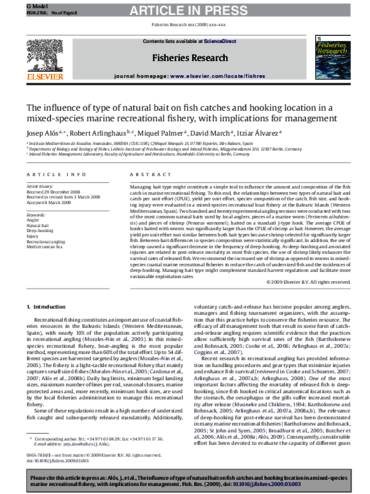Managing bait type might constitute a simple tool to influence the amount and composition of the fish catch in marine recreational fishing. To this end, the relationships between two types of natural bait and catch per unit effort (CPUE), yield per unit effort, species composition of the catch, fish size, and hooking injury were evaluated in a mixed-species recreational boat fishery at the Balearic Islands (Western Mediterranean, Spain). Two hundred and twenty experimental angling sessions were conducted with two of the most common natural baits used by local anglers, pieces of a marine worm (Perinereis aibuhitensis)and pieces of shrimp (Penaeus vannamei), baited on a standard J-type hook. The average CPUE of hooks baited with worms was significantly larger than the CPUE of shrimp as bait. However, the average yield per unit effort was similar between both bait types because shrimp selected for significantly larger fish. Between-bait differences in species composition were statistically significant. In addition, the use of shrimp caused a significant decrease in the frequency of deep-hooking. As deep-hooking and associated injuries are related to post-release mortality in most fish species, the use of shrimp likely enhances the survival rates of released fish. We recommend the increased use of shrimp as opposed to worms in mixed species coastal marine recreational fisheries to reduce the catch of undersized fish and the incidences of deep-hooking. Managing bait type might complement standard harvest regulations and facilitate more sustainable exploitation rates.
The influence of type of natural bait on fish catches and hooking location in a mixed-species marine recreational fishery, with implications for management
Rezensierter Artikel

Alós, J., Arlinghaus, R., Palmera, M., Marcha, D., Álvareza, I. (2009). The influence of type of natural bait on fish catches and hooking location in a mixed-species marine recreational fishery, with implications for management. Fisheries Research, 97, 270–277
Veröffentlicht
: 2009
Erschienen in
: Fisheries Research, 97, 270–277
